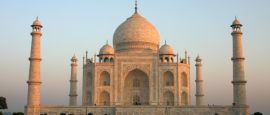Where to stay in India
Hotels in India offer the whole gamut of possibilities, from premier 5-star establishments and Heritage Hotels (converted historic palace buildings) to budget backpacker affairs and delightful back-to-basics beach huts. Modern and boutique hotels are available in all large cities and popular tourist centres. Business people are also well catered for. To experience full-on lavishness there are a number of palace hotels in Rajasthan and Shimla. Hotel services in the luxury and business range are comparable with other major cities and therefore can be very pricey particularly during tourist high season which runs from early October to February. However, even if you are not staying in 5-star hotels, you can still enjoy some of the luxury by booking in a spa service or have a meal at one of the hotel restaurants.
Hotel bills may be subject to a 10% expenditure tax, 7-15% luxury tax and a variable service charge.
Grading: Hotels in India range from 5-star deluxe, 5- and 4-star hotels, which are fully air-conditioned with all luxury features, 3-star hotels, which are functional and have air-conditioned rooms, to 2- and 1-star hotels, which offer basic amenities.
Bed and breakfasts are popular alternatives offering a more personal and local touch. The Government of India’s Ministry of Tourism (tourism.gov.in) has an updated, but not very user-friendly, list of approved B&Bs across India in two categories - gold and silver. Owners must follow strict guidelines to gain approval in each category.
Campsites are scattered throughout India, but are few and far between. Some hotels may permit camping on their grounds for a small fee which includes bathroom use. The easiest way to camp in India is with a tour operator.
Hostels: The Department of Tourism has set up several hostels, spread throughout many regions. Each has a capacity of about 40 beds or more, segregated roughly half and half into male and female dormitories. Beds with mattresses, sheets, blankets, wardrobe (often with locks), electric light points, member kitchen utensils and parking areas are usually available at each hostel. Some hostels are more impressive than others.
Tourist bungalow: There are tourist bungalows at almost every tourist centre in the country, under the control of the respective State Government Tourist Development Corporation. These usually include single, double and family rooms, most with attached bathrooms. Some properties have kitchen facilities, others can arrange meals.
Eco-style Hotels: Get up close and personal with nature in India through a range of eco-friendly accommodations such as luxury tents while tiger spotting in Ranthambore; check out a tea plantation and hike in the wilderness or mosey down the backwaters in Kerala in a house-boat.
Ashrams: Travellers seeking spirituality and ways to reset the mind and soul need look no further than India’s many ashrams catering to specific mental and physical needs. Sometimes there is a small charge for food and accommodation that is often basic, communal and separated according to gender. Courses in yoga and meditation may be offered at additional costs.
Homestays: These are another attractive option for those looking for a good-value, authentic visit. The Ministry of Tourism (tourism.gov.in) has a list of government-approved homestays.
Do you have any Feedback about this page?
© 2025 Columbus Travel Media Ltd. All rights reserved. No part of this site may be reproduced without our written permission, click here for information on Columbus Content Solutions.





 You know where
You know where
